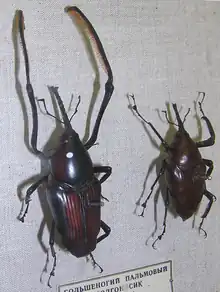| Rhynchophorini | |
|---|---|
 | |
| Male (left) and female specimens of Cyrtotrachelus dux | |
| Scientific classification | |
| Domain: | Eukaryota |
| Kingdom: | Animalia |
| Phylum: | Arthropoda |
| Class: | Insecta |
| Order: | Coleoptera |
| Infraorder: | Cucujiformia |
| Family: | Curculionidae |
| Subfamily: | Dryophthorinae |
| Tribe: | Rhynchophorini Schönherr, 1838 |
.jpg.webp)
Sphenophorus cicatristriatus, Rocky Mountain Billbug
.jpg.webp)
Cactophagus spinolae, Cactus weevil from Teotihuacan
The tribe Rhynchophorini is the largest member of the true weevil subfamily Dryophthorinae. Alonso-Zarazaga and Lyal (1999) treated it as a distinct subfamily, Rhynchophorinae (in the family Dryophthoridae).[1] Weevils of this tribe have the pygidium (VII abdominal tergite) not covered by the elytra.
This tribe includes the largest weevils of the subfamily, such as palm weevils.
Genera and selected species
- Abrachius
- Cactophagus LeConte, 1876[2]
- Cosmopolites Chevrolat, 1885[2]
- Cyrtotrachelus
- Dynamis
- Macrocheirus
- Mahakamia
- Metamasius Horn, 1873[2]
- Omotemnus
- Otidognathus
- Paratasis
- Pristirhina
- Protocerius
- Rhodobaenus LeConte, 1876[2]
- Rhynchodynamis
- Rhynchophorinus
- Rhynchophorus Herbst, 1795[2]
- Rhynchophorus palmarum – American Palm Weevil
- Rhynchophorus ferrugineus – Red Palm Weevil
- Rhynchophorus cruentatus – Palmetto Weevil
- Scyphophorus Schönherr, 1838[2]
- Sitophilus Schönherr, 1838[2]
- Sphenophorus Schönherr, 1838[2]
References
 Media related to Rhynchophorini at Wikimedia Commons
Media related to Rhynchophorini at Wikimedia Commons Data related to Rhynchophorini at Wikispecies
Data related to Rhynchophorini at Wikispecies
This article is issued from Wikipedia. The text is licensed under Creative Commons - Attribution - Sharealike. Additional terms may apply for the media files.